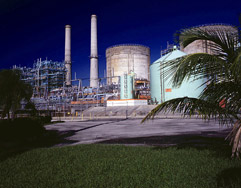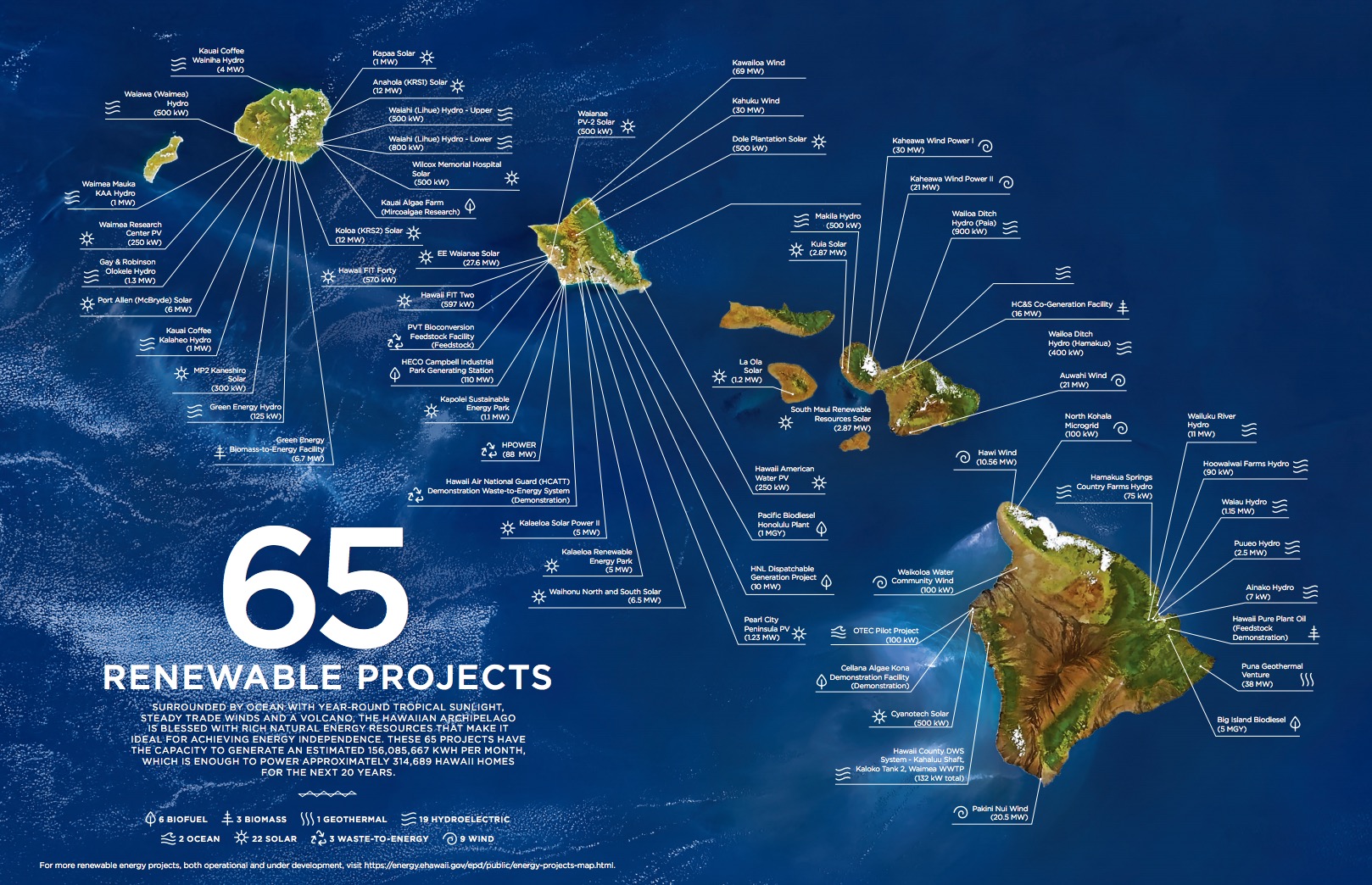HAWAII STATE ENERGY OFFICE
Executive Summary
With the establishment of the Hawaii Clean Energy Initiative (HCEI), the state set a bold and confident path for energy independence and security. It is that transformative journey that has yielded tremendous benefits to the state.
However, as the low-hanging fruit in the electricity sector are harvested, continued gains will require more and harder work. Completing Hawaii’s clean energy transformation will not be easy, and the state and other energy stakeholders must balance a great many demands, like managing utility costs, maximizing savings opportunities, and maintaining security, and system reliability. Transforming Hawaii’s energy ecosystem involves integration with larger and more complex aspects of energy in transportation. This must involve an array of interested parties from all sectors, public, private and non-profit, military and civilian, local and international. Clean energy represents a brand new sector of the economy that has grown exponentially from humble beginnings. This is occurring in an environment that is beginning to show the dramatic effects of climate change, the threat of which helped to spur the clean energy movement in the first place.
Fortunately, HCEI has proven to be as flexible and it is enduring. In addition to fulfilling the Energy Resources Coordinator’s statutory requirement, this report is in essence a catalog of HCEI’s breadth, describing its diverse range of activities, policy formulations, regulatory directives, approaches to innovation, collaborations and opportunities to advance Hawaii towards its many clean energy goals, which can be too easily overshadowed by the goal of reaching 100 percent renewable portfolio standards (RPS) by 2045. HCEI encompasses:
ENERGY EFFICIENCY DEPLOYMENT – While energy efficiency portfolio standards (EEPS) are no longer counted as part of Hawaii’s RPS, Hawaii continued to make progress in cutting down energy usage by improving efficiency. In 2015 Hawaii’s government agencies continued to lead the world in energy performance contracting, the best practice for financing energy improvements to buildings. An estimated 40 percent of energy is consumed in residential and commercial buildings, according to the Energy Information Administration. The state also continued advancements in new, energy-efficient construction, with building codes and financing for improvements that will save millions of dollars and cut millions of pounds of carbon dioxide emissions.
RENEWABLE ENERGY DEPLOYMENT – By separating EEPS from RPS in 2015, the state recognized that the two efforts, while mutually supportive, require different tools for measurement and have separate compliance mechanisms. Thanks to the success of HSEO and its many partners, renewable energy efforts have received worldwide attention.
In 2015, Hawaii achieved a statewide RPS level of 23.4 percent, up from 21.1 percent in 2014, with notable advances in solar and wind. Hawaii is now almost a quarter of the way to its trailblazing goal of a 100 percent RPS by 2045.
ENERGY PLANNING AND TRANSPORTATION SOLUTIONS – An important aspect of HCEI that deserves more attention is clean transportation. Compared to RPS progress, Hawaii has much ground to make up in shifting the enormous amount of energy used on transportation from petroleum to renewable resources. The wealth of knowledge gained from the HCEI Transportation Energy Analysis (HTEA) establishes a firm and credible framework for the next phase as stakeholders are reconvened to plan and plot a course to bring the tactics and solutions onto roadways, airways and sea lanes.
Similarly, painstaking planning is ongoing to address needs across the entirety of HCEI policies and programs to ensure that progress is on the right path with the flexibility necessary to adapt to a changing energy landscape. HSEO is working to enhance internal capacity and modeling capabilities to better integrate renewable resources onto the grid while bolstering energy security and assurance in case of emergencies.
POLICY AND REGULATORY ADVANCEMENTS – HSEO continues to work with legislators and regulators to develop policies that support and encourage energy independence. Of major note in 2016 was the Public Utilities Commission’s (PUC) ruling dismissing NextEra Energy’s proposed acquisition of Hawaiian Electric Industries Inc. in accordance with HSEO’s view that NextEra failed to demonstrate that the deal was reasonable and in the public interest.
OUTREACH AND STAKEHOLDER ENGAGEMENT – A great deal of HSEO’s success in advancing Hawaii’s clean energy agenda occurs behind the scenes in creating the foundation for sharing and advancing knowledge, resources and capacity needed to make the clean energy vision a reality. From innovative financing tools to electric vehicle charging station locating apps, from global conferences to memoranda of understanding with the U.S. military and international partners, the emerging clean energy sector in Hawaii is well covered.
ABOUT THE ENERGY RESOURCES COORDINATOR – According to the Hawaii Revised Statutes, Chapter 196-4, the Director of the Department of Business, Economic Development & Tourism is the state’s Energy Resources Coordinator (ERC), responsible for energy planning, policy and programs. The ERC has delegated that responsibility to HSEO, which is actively positioning the state as a global leader in clean energy innovation.
Hawaii’s Clean Energy Vision
Seeing Commitments Through
THE HAWAII STATE ENERGY OFFICE’S (HSEO) mission is to maximize Hawaii’s energy self-sufficiency and security by developing and utilizing local energy resources in a balanced way. In doing so, HSEO will guide our state toward the HCEI MAX goals to achieve 100 percent renewable energy in the electricity sector by 2045, reduce electricity consumption by 4,300 gigawatt-hours by 2030, and reduce petroleum use in transportation. To this end, HSEO works toward the deployment of clean energy infrastructure and serves as a catalyst for energy innovation and test bed investments. By achieving these goals, HSEO will grow the clean energy sector and transform Hawaii’s economy.
Aiming for 100 percent renewable energy in Hawaii’s electricity sector by 2045 was big news last year. It’s now time to put those words into action, which will not be an undertaking for the faint of heart. Achieving Hawaii’s bold commitments will require even bolder actions – a combination of hard work, innovative thinking and a continuation of the collaboration that has underpinned Hawaii’s clean energy transformation to date.
There will be no shortage of challenges. Accommodating more intermittent renewables on increasingly saturated electric grids, developing the expertise to deliver technical solutions, attracting the large amounts of capital necessary to finance the transformation and dealing with legacy issues such as stranded costs and long-term fossil fuel assets are just a few of the hurdles that will have to be overcome. Still, there are reasons to be optimistic. Among them:
- The clean energy movement is gaining traction globally, with the traditional base of supporters growing to include deep-pocketed investors looking to capitalize on what they see as a significant growth market.
- As renewable energy approaches critical mass worldwide, innovation is driving down the cost of renewables everywhere, including Hawaii.
- Hawaii has the invaluable support of the U.S. Department of Energy and its network of national laboratories for key clean energy projects in Hawaii, such as grid modernization and data visualization.
- Hawaii continues to build its credentials internationally as a place where next-generation clean energy solutions will be born.
- Stakeholders drawn together under the umbrella of the HCEI are strengthening their resolve to make Hawaii’s clean energy vision a reality
Download full version (PDF): Hawaii’s Emerging Future
About the Hawaii State Energy Office
energy.hawaii.gov
With the state’s goal to reach 100 percent renewable energy generation by 2045, the Hawaii State Energy Office (HSEO) is leading the state’s charge toward clean energy independence. HSEO is committed to developing and deploying high impact solutions that will maximize Hawaii’s renewable energy resources and improve efficiency and transportation standards. Through effective policies and innovative programs, HSEO has positioned Hawaii as a leader in clean energy innovation, which will generate quality jobs, attract investment opportunities and accelerate economic growth.
Tags: Hawaii, Hawaii Clean Energy Initiative, Hawaii State Energy Office, HCEI, HI, Renewable Energy, Renewables







 RSS Feed
RSS Feed